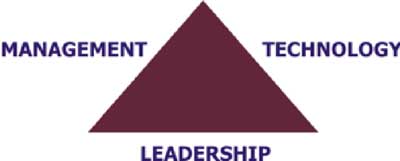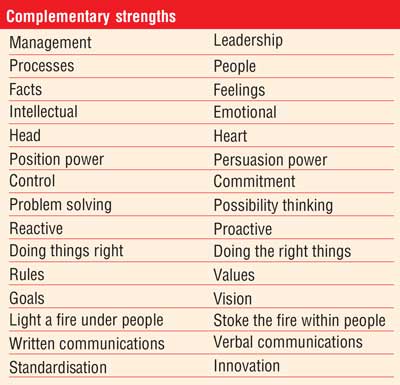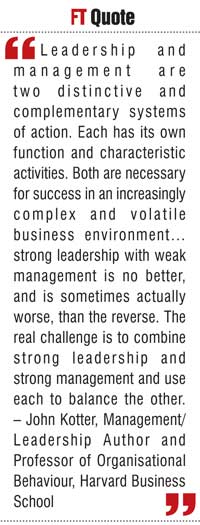Tuesday Mar 18, 2025
Tuesday Mar 18, 2025
Monday, 16 November 2015 00:00 - - {{hitsCtrl.values.hits}}

The terms ‘management’ and ‘leadership’ are often interchanged. In fact, many people view them as basically the same thing. Yet management is as distinct from leadership as day is from night. Both are necessary, however, for a high-performance organisation. By contrasting them and understanding their differences, we can better balance and improve these essential roles.
One key distinction between management and leadership is that we manage ‘things’ and lead ‘people’. Things include physical assets, processes, and systems. People include customers, external partners, and people throughout our team or organisation (or ‘internal partners’). When dealing with things, we talk about a way of ‘doing’. In the people realm, we’re talking about a way of being.
In the people realm, we’re talking about a way of being.
In The Clemmer Group’s consulting and training work we often add a third element – technical – to management and leadership to form what we call a ‘Performance Triangle’. This adds another dimension to the question, ‘How should the organisation’s focus be allocated to each area?’ While apparently simple, the question is often a very difficult one to answer, since there is no universal formula that applies to all organisations. Some need more technical skills or better technologies. Others need the discipline of better systems and processes. Most need a lot more leadership.
The triangle depicts the balance between the three critical success factors. Imagine a pendulum swinging in the centre of the triangle. It’s very difficult to keep the pendulum in a state of equilibrium. In some cases, organisations may need to swing the pendulum in one direction because that’s where it’s weakest. For example, entrepreneurial start-up companies often have strong vision, passion, and energy (leadership) and may also have good technological or technical skills. But their lack of systems and processes or poor management discipline leads to a lot of errors, poor service/quality, and frustration for customers and people in the organisation.
The most common weakness, however, is in leadership. The triangle illustrates that a well-balanced organisation has leadership at the base. This allows management and technology to serve rather than enslave producers, servers, and customers.
Another complicating factor is that needs are easily misidentified. For example, we have found that most organisations have communication problems of one kind or another. Often these are seen as leadership issues. Many times they are. But just as often the roots of the problem are intertwined with poor processes, systems, or structure – all of which are management issues.
While it is important to recognise the differences between leadership and management, it is also important to appreciate that the two have complementary strengths, as well.
Warren Bennis, Professor of Business Administration at the University of Southern California, has been extensively studying and writing about leadership for many decades. He explains why leaders are so much more successful than managers, in harnessing people power: “Management is getting people to do what needs to be done. Leadership is getting people to want to do what needs to be done. Managers push. Leaders pull. Managers command. Leaders communicate.”
Both management and leadership are needed to make teams and organisations successful. Trying to decide which is more important is like trying to decide whether the right or left wing is more important to an airplane’s flight. I’ll take both please!
Discover Kapruka, the leading online shopping platform in Sri Lanka, where you can conveniently send Gifts and Flowers to your loved ones for any event including Valentine ’s Day. Explore a wide range of popular Shopping Categories on Kapruka, including Toys, Groceries, Electronics, Birthday Cakes, Fruits, Chocolates, Flower Bouquets, Clothing, Watches, Lingerie, Gift Sets and Jewellery. Also if you’re interested in selling with Kapruka, Partner Central by Kapruka is the best solution to start with. Moreover, through Kapruka Global Shop, you can also enjoy the convenience of purchasing products from renowned platforms like Amazon and eBay and have them delivered to Sri Lanka.
Discover Kapruka, the leading online shopping platform in Sri Lanka, where you can conveniently send Gifts and Flowers to your loved ones for any event including Valentine ’s Day. Explore a wide range of popular Shopping Categories on Kapruka, including Toys, Groceries, Electronics, Birthday Cakes, Fruits, Chocolates, Flower Bouquets, Clothing, Watches, Lingerie, Gift Sets and Jewellery. Also if you’re interested in selling with Kapruka, Partner Central by Kapruka is the best solution to start with. Moreover, through Kapruka Global Shop, you can also enjoy the convenience of purchasing products from renowned platforms like Amazon and eBay and have them delivered to Sri Lanka.